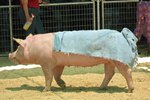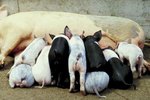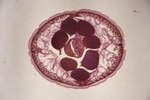In a living pig, the liver performs the same function as a human liver. The liver makes bile, lipids, cholesterol, albumin and other proteins. It is also a conversion center where glucose is converted to glycogen or fat and glycogen is converted back to glucose. It serves as a storage center for iron, vitamins and glycogen for the body to use when needed. The pig's blood is detoxified in the liver. The liver filters out poisons and chemicals and recycles hemoglobin from the bloodstream.
When the pig is a fetus in its mother's uterus, the liver contributes to the production of blood cells.
Liver Disorders in Pigs
Tuberculosis is a bacterial infection in pigs that results in a chronic infection that causes fever, loss of appetite and difficulty breathing. The bacteria commonly cause a localized liver infection that results in the development of miliary lesions -- so named because they resemble millet seeds-- on the organ.
Another bacterial infection that affects a pig's liver is Brucellosis. In some cases, pigs do not show symptoms of infection, but it can result in abortions, inflammation of the testicles and lameness. Internally, the disease causes abscesses in the liver and other organs.
Cysticercus is caused by a tapeworm that infects the liver, brain, heart and muscles. Infected pigs display muscle stiffness and fever. The disease causes cysts to develop in the liver.
Ascariasis is a parasitic disease that causes the liver to become enlarged and blocked. In chronic cases, milk spots and lesions on the liver develop. The roundworm that causes ascariasis usually infects young pigs and causes slow growth, cough and difficulty breathing.
Toxoplasmosis is a contagious protozoan disease that causes fever, pneumonia, weakness, coughing, difficulty breathing, lack of coordination, diarrhea and abortion. Young pigs often die from the disease. The protozoan causes cysts on the liver, brain and muscles and necrosis, or cell death, of the liver, kidneys and spleen.
Parasites That Affect the Liver
Pigs are also susceptible to several parasites that may affect the liver. Large roundworm larvae, for example, pass through the liver and may cause milk spots, scarring or an allergic reaction and inflammation of the liver. Kidney worms also pass through the liver and cause heavy scarring before moving to the kidneys and back muscles.
Writer Bio
Maureen Malone started writing in 2008. She writes articles for business promotion and informational articles on various websites. Malone has a Bachelor of Science in technical management with an emphasis in biology from DeVry University.




